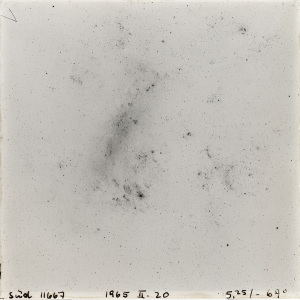Looking at the explosive past of the stars

FAU’s unique astronomy collection is being digitised and promises many new discoveries
Those who enter the archive of the Astronomical Institute of Friedrich-Alexander-Universität Erlangen-Nürnberg (FAU) can see a little chapter of the history of the universe with their own eyes. At the Dr. Karl Remeis Observatory in Bamberg, 40,000 photographic plates are safely stored in steel cabinets, showing approximately five decades of the history of stars. A large part of these records is absolutely unique and of immeasurable value for astronomical research. This is why FAU researchers have now begun the complex process of digitising the records. The project, which receives funding from the German Research Foundation (DFG), is a joint effort together with colleagues from the University of Hamburg and the Leibniz Institute for Astrophysics Potsdam, which houses another 45,000 historical photographic plates.
Several generations of scientists have worked to compile the archive of the Astronomical Institute. It contains the results of two astronomical surveys that were carried out in order to find what is known as variable stars – stars whose brightness fluctuates over the the course of longer periods – and thus to find out more about the life cycle of stars and the frequency with which star explosions occur.
In 1925 astronomers in Bamberg started systematically photographing the northern night sky. Between 1963 and 1976, the researchers observed the stars from observatories in South Africa, New Zealand and Argentina. These images – altogether 20,000 plates – are unique, as there were no other astronomical projects observing the southern sky in the 1960s.
Recording the night sky on a photographic plate was a laborious process: the negative in the wide angle camera had to be exposed manually for an hour in order to ensure that even faint stars would be visible. Today researchers have robotic telescopes at their disposal that can be linked up to the Internet, and highly sensitive cameras that can create images showing even faint sources of light.
Analysing the photographic plates was also arduous: every single one shows between ten and hundred thousand stars. Looking for variable stars was therefore like searching the proverbial needle in a haystack. The most important tool used by the astronomers was the blink comparator, which allowed them to compare two images of the same section of sky and which worked much like a flip-book. The apparatus shows the two photographic plates in quick succession, making variable stars visible as blinking dots. Using this method, FAU scientists have discovered approximately 1700 such stars, which have gone down in specialist literature as the ‘Bamberg Variables’. ‘But this is just the tip of the iceberg,’ says Prof. Dr. Ulrich Heber of FAU’s Astronomical Institute. ‘We can now extend the list of Bamberg Variables using modern computer technology – although the surveys ended almost 40 years ago.’
This is why the researchers have taken the plates out of storage and have started scanning them in high resolution and linking them to what is known as the log entries. These are notes that the scientists made during their observations and while analysing the images. The notes reveal, for instance, when and where the images were recorded. The massive amount of data this generates – altogether ten terabytes – has to be processed and calibrated exactly with the help of complex algorithms. Once this work has been completed, scientists from all over the world can use the material. Through the international Virtual Observatory, the images will be linked with countless other astronomical surveys and will be available to everyone. Historical images can thus be compared with current pictures, allowing us to arrive at brand new insights regarding the birth, life and death of stars…
Further information:
Prof. Dr. Ulrich Heber
Phone: +49 (0)951 95222 14
Ulrich.Heber@sternwarte.uni-erlangen.de
The photographic plate, approx. 16 by 16 centimetres in size, dates back to the astronomical survey of the southern sky carried out at the Boyden Observatory in South Africa. It shows the Large Magellanic Cloud, the neighbour galaxy to our Milky Way. The markings show where a researcher suspected possible variable stars. (Image: FAU)